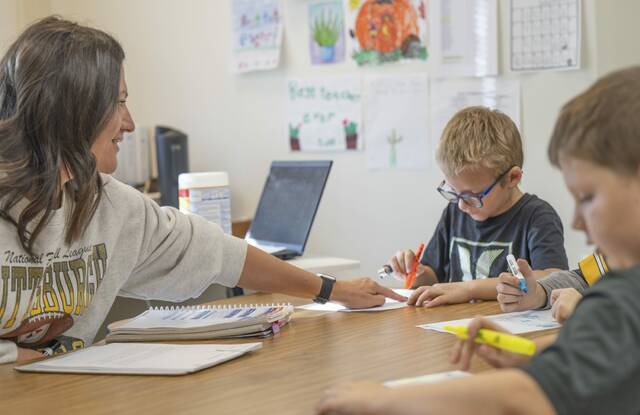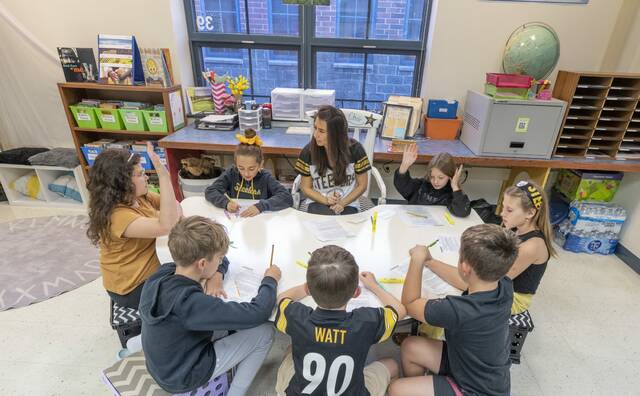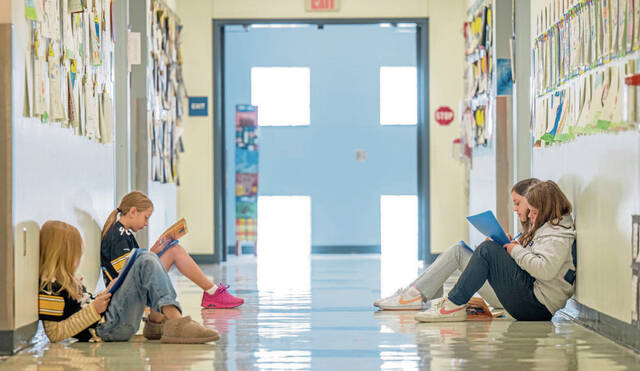Increased school funding could lead to higher test scores — but it's often more complicated
When it comes to education spending, more isn’t always better.
At least that’s what the numbers — standardized test scores and per-student spending — suggest about Southwestern Pennsylvania’s school districts.
School districts that spend the most per student do not always have the highest test scores, according to data from the state Department of Education.
But assessing the impact of education funding on student learning is not as simple as comparing dollars and test scores. Factors including where a district is located and what types of students it educates complicate the equation, said Linda Darling-Hammond, founder of education nonprofit Learning Policy Institute.
“When you look at the raw data, it’s not controlling for differences in the cost of living or in the composition of the students,” she said. “Quite often in a city, you’ll have a lot of students with greater needs — more immigrant students, more students who are low income — and you may also have a higher cost of living.
“You have to parse all of that out to get to an apples-to-apples comparison with other districts.”
Pennsylvania’s education funding was thrust into the spotlight in February 2023, when a Commonwealth Court ruling deemed the system unconstitutional.
The PA Education Law Center and Public Interest Law Center filed a lawsuit on behalf of six school districts, two statewide associations and several parents in November 2014, arguing the state’s formula for funding public schools violated the state constitution. That led to supplements starting in 2024 that were designed to aid schools with large “adequacy” gaps and high tax burdens.
The state dedicated $526 million to its so-called “adequacy formula.”
Education funding also proved to be a focal point of the state’s latest budget, approved last week after a nearly 41⁄2-month impasse. The spending plan increased funding to the state’s 500 public schools by more than $900 million — including a $565 million allocation to the adequacy formula.
Darling-Hammond launched the California-based Learning Policy Institute in 2015 after earning her doctorate and teaching at several universities. Her goal is to bridge the gap between education research and school policies.
The institute has a team that works with states to create equitable school funding systems.
The general consensus from its research? Students have better outcomes when their school district spends more on the students with the greatest needs, including special education, English language learners and students eligible for free or reduced lunch, Darling-Hammond said.
“When the additional money is spent on the kids who need it most, in a reliable way,” she said, “and it reaches a level of adequacy to cover the expenses that the school districts have … you do see gains in achievement.”
Experts: Not all spending benefits learning
Neal McCluskey, an education policy analyst, has a slightly different take.
McCluskey has examined school choice, federal education policy, education spending and national K-12 test results during his 22-year tenure at Cato Institute, a Washington, D.C.-based think tank.
There is some evidence, he said, that school spending can make a difference in student learning — particularly through early intervention with students from low-income families or individualized tutoring.
“But the broad evidence,” McCluskey said, “suggests that we’ve been spending a lot of money in ways that aren’t making a difference. It’s very important to get beyond any kind of simplistic notion that more spending always leads to better outcomes.
“It’s very important how it’s spent and, it appears, who it’s spent on.”
Even Darling-Hammond admits not all school spending is beneficial to student learning — namely facility upgrades.
Districts may need to make building improvements or replace an HVAC system, she said. But pouring millions into a new athletics facility is another story.
“If you’re building football fields, you’re not likely to see gains in achievement,” she said.
How it’s calculated
Cost per student is calculated by dividing a district’s general fund expenses by its average daily membership — the average number of students attending the school each day, said Erin James, spokesperson for the state Department of Education.
Students enrolled in a local career and technical center or one of the state’s 14 public cyber charter schools are included in the average daily membership, James said, because districts are — at least in part — financially responsible for them.
Expenses related to instruction, capital improvements, special education, cyber charter and debt service are included in a district’s general fund, James said. Non-general fund expenses, such as food service, are not calculated into the cost per student, she said.
‘Test scores are just a proxy’
There’s debate in some circles about the merits of using test scores as a metric of student learning.
“A lot of people simply don’t think that’s the most important measure of education and that particular tests aren’t measuring everything that people might want,” McCluskey said.
He has seen research using graduation rates, parental satisfaction and school choice to assess education quality.
“I don’t think that there is one agreed-upon measure,” he said, “because there isn’t one agreed-upon measure of what we want out of education.”
Darling-Hammond agreed that test scores predict only so much about a student’s future. Metrics such as teacher retention, student attendance and later-in-life earnings may paint a clearer picture of the benefits of school spending, she said.
“I think that there is value in all of the (metrics),” she said. “I think those studies that have been able to look far out into the life course are very valuable because ultimately test scores are just a proxy for what we hope will be access to later life opportunities.”
Educator questions validity of test scores
Kiski Area Superintendent Jason Lohr, for one, believes state test scores are an incomplete assessment of the district’s 3,600 students.
After struggling with math in the early 2000s, the majority of Kiski Area’s students — between 70% and 80% — achieved a proficient or higher score on state tests by 2015.
Less than a decade later, 2024 Keystone Exams results show 40% of students achieving this mark on the algebra 1 exam.
“What happened? Did our kids stop knowing how to do math?” Lohr said. “Or were we not preparing them to be able to take the standardized tests and answer the questions they were being asked?”
Related:
• Educators question validity of national report claiming decline in test scores
From Lohr’s standpoint, some of the most valuable measures of student success are not measured by state tests, among them involvement in extracurricular activities, credentials received at a local career and technical center, and post-graduation outcomes.
“Our community says, ‘We want our kids ready for life and ready to either enter the workforce or ready to go into postsecondary education,’ ” he said. “I don’t see anybody hanging up their standardized test results in their house. I see them taking pictures of their kids at their first job. I’m seeing a high school diploma hanging there. Those are the things that we celebrate.”
What the numbers say
Among the 60 school districts in Allegheny and Westmoreland counties, Pittsburgh Public Schools reported the highest cost per student in 2023-24, according to the latest available annual financial report from the state Department of Education.
The second-largest school district in the state, Pittsburgh Public spent about $33,500 per student in 2023-24 — up more than $8,000 from 2019-20.
Norwin School District reported the lowest cost per student in the two-county region, nearly $16,800.
Despite the high spending figure, Pittsburgh Public Schools fell in the middle of the pack in performance on the 2024 Keystone Exams, according to Department of Education data.
The Keystone Exams — which include biology, literature and algebra 1 assessments — are administered in all 500 of the state’s public school districts. They typically are taken by students in grades 8 to 11.
Of the Pittsburgh Public students who took the 2024 Keystones, 57% scored proficient or higher in literature, 35% in biology and 26% in algebra 1.
At Norwin, the majority of students scored proficient or higher on the exams: 70% in biology, 85% in literature and 64% in algebra 1.
Pittsburgh Public Schools officials did not return repeated messages seeking comment for this story.
Norwin Superintendent Natalie McCracken said the district’s teachers play the greatest role in preparing students for state assessments.
“Part of our budget is textbooks, technology and things that help students learn,” McCracken said, “but the human resources are really what pull it all together and enable our students to be successful.”
‘Everything costs more in a city’
Pittsburgh Public and Norwin could not be more different.
Pittsburgh Public Schools tends to its 17,950 students, 4,470 employees and 54 school buildings with a $752 million 2025 budget.
Norwin approved a nearly $95.5 million budget in June to support its 5,000 students, 325 teachers and seven schools in 2025-26.
About 63% of Pittsburgh Public’s students were identified as low income last year, according to the latest available data from the state Department of Education. Just 30% of Norwin’s students fell into that category.
Part of the reason for the disparity likely comes from the districts’ locations, said Darling-Hammond. Pittsburgh Public sprawls across a bustling city. Norwin is tucked into a rural Westmoreland County suburb.
School district spending is largely dependent on local property taxes, Darling-Hammond said. That means schools with higher property values — which cities commonly have — are able to spend more.
But these schools also tend to have students with greater needs, she said — such as low-income and immigrant students.
“We know that in low-income households, students have fewer opportunities for lots of things, including summer programs and books in the home, tutors,” she said. “We know that English learners need additional resources to be able to both master the curriculum and master the language.”
Security expenses and costs to maintain aging facilities also tend to be higher in cities, Darling-Hammond said.
“The rent is higher. The cost of purchasing a building — the land costs more,” she said. “Everything costs more in a city than it does in a rural community.”
Improvements on the horizon
Darling-Hammond completed her doctoral dissertation on Pennsylvania school finance in 1978. To say she feels vindicated by the state’s recent efforts to more equitably fund schools is an understatement.
“I thought, ‘Wow, I did my dissertation in 1978, and it’s only 50 years later that they’re finally doing something,’ ” she said.
But in Darling-Hammond’s assessment, Pennsylvania won’t see the impact of its increased education investments for another three to eight years.
“What happens when districts are underresourced for a period of time is that they lose capacity,” Darling-Hammond said. “People don’t want to work there. The salaries aren’t adequate. All of the other functions are not adequately funded.
“It takes a while, then, to build back the capacity.”
Quincey Reese is a TribLive reporter covering the Greensburg and Hempfield areas. She also does reporting for the Penn-Trafford Star. A Penn Township native, she joined the Trib in 2023 after working as a Jim Borden Scholarship intern at the company for two summers. She can be reached at qreese@triblive.com.
Remove the ads from your TribLIVE reading experience but still support the journalists who create the content with TribLIVE Ad-Free.




